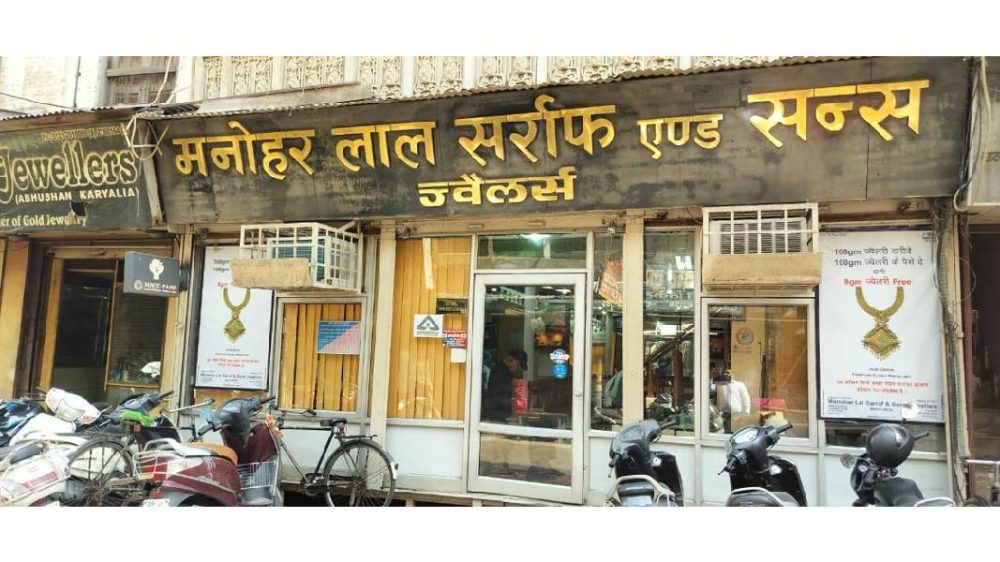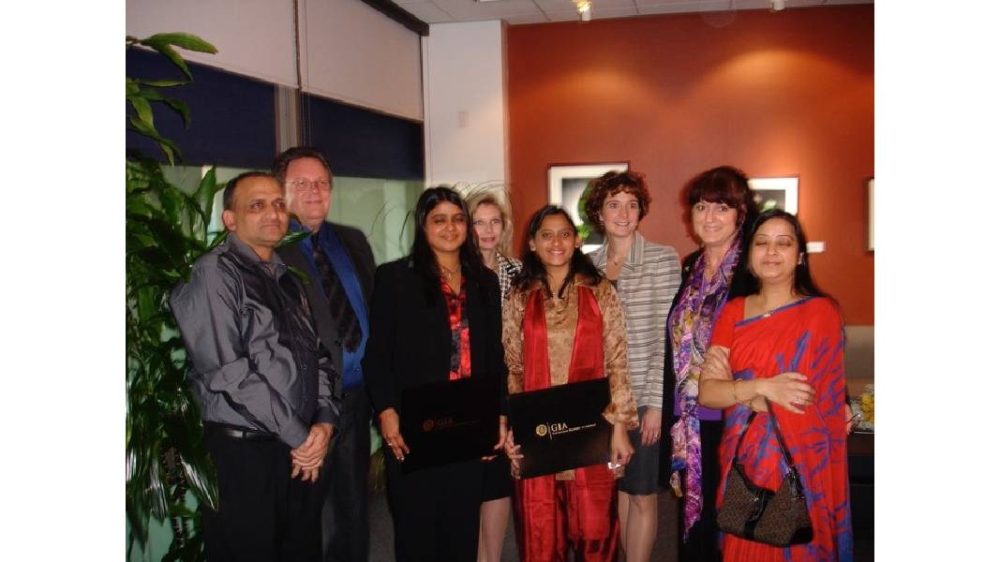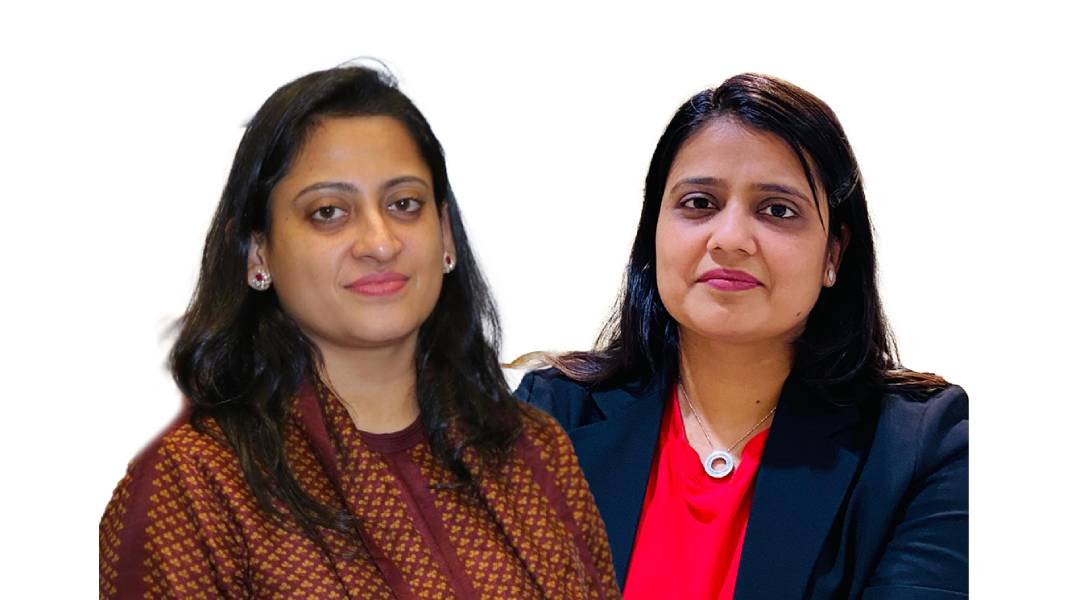Aarti Shekhar, GIA Graduate Gemologist®, Manohar Lal Sarraf & Sons Jewellers, Meerut
“At GIA We encountered individuals from diverse backgrounds, each bringing unique insights. Their perspectives sparked innovative ideas that shaped our business strategies and personal development.”
Swati Shekhar, GIA Graduate Gemologist®, Manohar Lal Sarraf & Sons Jewellers, Meerut
“While early exposure to the trade lays a solid foundation. Formal education shapes personal development and ensures the continuity of family legacy.”
Q1. Could you share the history of Manohar Lal Sarraf & Sons Jewellers and discuss your experience as the fourth generation in your family’s business?
Aarti: The legacy of Manohar Lal Saraf and Sons began in 1918 with my great-grandfather, Manohar Lal Saraf ji. Over the years, our business flourished, and in 1983, it was formally established with my father and uncles working together in Meerut.
In 2006, we both completed our GIA GG® and this broadened our horizons. Through the program, we discovered the vast potential of colored gemstones, which inspired us to launch M.L. Natural Gems that focuses exclusively on natural, untreated, and rare gemstones, marking a significant step into the market.
Swati: When we were poised to enter the family business, my father emphasized the importance of gaining independent experience first. He believed that establishing ourselves outside of the family business would foster a deeper appreciation for its values and enable us to contribute more meaningfully. To formalize this approach, he had us sign an agreement committing us to pursue our own ventures and achieve specific financial and professional milestones before entering the family business. We then decided to enroll at GIA. The following year we were able manage and scale up M.L. Natural Gems, which helped us in proving our capabilities and earning respect and credibility in the family.
Q2. Could you share insights into the practices that have contributed to the success and longevity of Manohar Lal Saraf and Sons in Meerut?
Swati: Meerut holds a significant place in the Indian freedom struggle, and it also known as the “gold city” for its thriving gold manufacturing industry. It remains distinguished for its robust demand for high-quality VS and VVS diamonds. Meerut residents prioritize jewelry that offers both value for money and durability, designed to withstand everyday wear and tear.
Meerut’s reputation for impeccable craftsmanship continues to draw clients not just from all corners of India, but also from the UK and US. International customers often visit directly from the airport or engage in seamless online transactions, drawn to the authentic Indian designs that reflect local artistry and cultural heritage. Our legacy and craftsmanship uniquely positions us to cater to clients from around the world who are drawn to Meerut seeking for quality and heritage.
Q3. What according to both of you, are some of the qualities the next generation should possess if they wish to scale the family business?
Swati: Similar to how rough diamonds require cutting and polishing before they are ready for sale, individuals in family businesses must refine themselves like diamonds. While exposure to the family business from a young age provides a foundational understanding, formal education plays a crucial role in personal development and carrying forward the family legacy. It’s vital to immerse oneself fully in every aspect of the business, acquiring comprehensive insights and skills. This thorough preparation is key to scaling up effectively and achieving lasting success.
Aarti: In today’s market, consumers are exceptionally well-informed and engaged. They know exactly what they want and are eager to learn more. Staying informed and knowledgeable in this environment requires investing in formal education, diverse training experiences, internships, and exploring different perspectives independently. These efforts are crucial for long-term business growth.
Additionally, understanding the existing value systems and how they have contributed to the current state of your business is essential. Aligning with these values while propelling them forward presents a significant challenge for entrepreneurs. It’s about recognizing where your business stands, appreciating its journey, and strategically advancing it in line with evolving consumer demands and market dynamics.
Q4. As young leaders with such a rich legacy, do you feel the pressure of complying with traditional set business practices? If yes, how did you deal with it?
Aarti: Navigating these challenges is a constant in our journey, requiring alignment and synchronization. We engage in open discussions and debates within our team, exploring all options before making decisions that align with both our short-term and long-term goals. This ongoing dynamic is especially intriguing in our family business, where some team members have been with us since before we were born. It’s about respecting their wealth of experience and insights accumulated over the years. We integrate their wisdom with our own contemporary perspectives, aiming to advance the business while staying true to our heritage.
Swati: In fact, I’d like to share an incident from our showroom. We had three necklaces to order, and a team member proposed a specific design that initially didn’t align with our vision. However, we eventually reached a middle ground that satisfied everyone.

Aarti Shekhar: “This shop was a familiar sight during our formative years. Visiting it occasionally allowed us to experience its unique atmosphere firsthand.”

Commentary by Aarti: “This graduation photo was taken in 2006 when our parents traveled to join us for this milestone moment. Here, we’re surrounded by our teachers, from the diamond instructors to the senior color stone instructors.”
Q 5. As leaders in this industry, what according to you are the top four trends that you foresee will unfold in the next 10 years?
Aarti: In our industry we prioritize three core elements: gold, diamonds, and laboratory grown diamonds and colored stones each with its own evolving dynamics. Gold continues to be a resilient investment, bolstered by recent government measures aimed at enhancing transparency and buyer confidence. India’s commitment to transparent systems positions it as a future leader in the gold market. There’s a notable interest in both machine-made and handmade jewelry which is particularly thriving in regions like Meerut and the NCR.
Regarding gemstones, the shift over the past decade and a half has been profound. Initially, certification and market knowledge were lacking, but now, access to reputable laboratories and certification processes has significantly improved. This transformation, buoyed by the influence of social media and digital platforms, has empowered consumers to make informed choices, prioritizing product knowledge and quality assurance over traditional buying practices.
In terms of trends, the divide between natural and lab-grown diamonds remains pronounced. While some embrace laboratory-grown diamonds others still prefer natural diamonds for their traditional allure and value.
Swati: The timeless appeal of natural diamonds is unmistakable. Many prioritize authenticity, cherishing the enduring beauty and intrinsic value of natural diamonds. Whether acquiring a single piece or a collection, the preference for natural diamonds persists due to their strong investment potential and high resale value, particularly valued in the Indian market. Their emotional and financial significance makes them a premier choice for discerning buyers.
Furthermore, there is a notable rise in interest for larger natural diamonds, ranging from 10 to 20 carats, indicating a shift towards luxury and opulence in jewelry preferences.
While lightweight gold jewelry remains popular, there continues to be a robust demand for heavy pieces, especially favored by brides for their wedding day. This desire extends to other family members as well, highlighting the enduring appeal of heavy jewelry pieces.
In contrast, styles like polki and kundan jewelry may see fluctuations influenced by changes in the gold market, showcasing the dynamic nature of jewelry trends.
Q6. What are some of the most interesting colored stone buying preferences that you see across generations?
Aarti: In recent years, there’s been a noticeable global shift towards embracing colorful gemstones in jewelry trends. While white diamonds dominated a decade ago, today there’s a strong preference for vibrant hues. Millennials and younger generations often view diamonds as commonplace, whereas gemstones are seen as having their own distinct identity.
We’re noticing an increasing number of young professionals approaching us with precise demands, such as custom shapes for colored gemstone, to stand out from the crowd. These clients are well-informed about quality and pricing, having done their research. They’re looking for exclusivity, opting for lesser-known gemstones or unconventional cuts that aren’t as commonly worn. They prioritize making a personal statement rather than following mainstream trends, which reflects their unique approach to selecting jewelry.
Swati: One of the most intriguing experiences I’ve had involved a gentleman in his seventies who was on a quest for a Burmese ruby. He was very particular about the ruby being of the highest quality—optimal color, clarity, and certified above 10 carats. When asked why, he explained that he wanted to include it in his will as a unique possession, something no one else would ever have. This mindset highlights the cultural significance people attach to gemstones compared to diamonds. While diamonds may symbolize prestige and tradition, colored gemstones, each with its distinct hue, hold a special allure. Natural gemstones are inherently unique; no two stones are exactly alike, emphasizing their individuality and intrinsic value.
Q7. What are your thoughts on the role of gemstone grading and identification in building consumer trust? How do you at ML build and maintain consumer confidence?
Aarti: At ML Natural Gems, we often feel lost at the counter. We’re used to some customers coming in with specific requests like carat size or gem type, but beyond that, there’s often uncertainty. We strive to educate our customers and emphasize the experience of acquiring something truly unique from nature. Our learning curve over the years has taught us when to provide detailed information and when to step back, respecting the customer’s decision-making process. It’s essential to strike the right balance, ensuring customers are well-informed and understand the value of their purchase.
Q 8. Can you share with us how you get along with each other tackling some of the challenges of operating in a family business, all while maintaining unity amidst diverse views?
Swati: Reaching consensus took time because everyone had different perspectives. For instance, I might see option A while someone else sees option B. However, our primary focus remains on achieving the main goal.
The critical aspect is always the end goal. How we reach it, whether through path A or path B, is secondary. What truly matters is the growth and success of the organization. You can’t expect growth by staying the same, nor can you achieve it with conflicting goals.
While the paths to success may vary, our approach is balanced and organic. I excel in sales, while Aarti excels in procurement. This complementary dynamic ensures that we remain unified and effective in our roles, driving the organization forward.
Aarti: I believe it’s about recognizing your individual strengths and weaknesses and leveraging them effectively within the company. Initially, we had many differences; working together wasn’t an instant success. Our family decided that either both of us would go to GIA or neither would. So, while still in college, we took a six-to-eight-month break and attended GIA together.
It was a unique experience, as we had never been in the same class before. Studying and evolving together, we decided to start our company as a team. This journey taught us a lot about resolving conflicts and collaborating effectively. Ultimately, it’s about teamwork – understanding that we need each other to grow and succeed.
Q 9. What is one of your most-cherished moments while on-campus at GIA?
Aarti: Our journey to GIA Carlsbad campus marked our first international trip and a transformative experience. Before that, neither of us had traveled abroad, and suddenly, it was just the two of us, managing everything on our own without any family support. We had to handle cooking three meals a day, studying, and completing assignments. We never missed a single class, GIA instilled in us a strong sense of discipline. We quickly realized that cooking three times a day wasn’t sustainable, so we adapted to cooking only once. One of us would cook while the other read out the book or worked on assignments, constantly revising and posing questions to each other. It was never a competition between us; it was always about supporting each other’s knowledge and growth.
Our time at GIA was incredibly formative. We were the youngest in our class, fresh out of high school, while most of our classmates had already completed their formal education and had work experience. Despite our age, we immersed ourselves fully, learning not just about gemstones, but also about different working cultures and perspectives from around the world.
The GIA’s Carlsbad environment was amazing, filled with opportunities to learn and expand our horizons. We met people from various countries, each with unique insights and ways of thinking. This exposure allowed us to implement new ideas and approaches in our business and personal lives. Even years later, we’re still in contact with many of our classmates.

